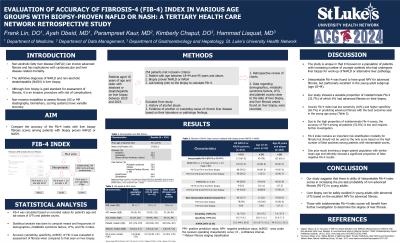Monday Poster Session
Category: Liver
P2860 - Evaluation of Accuracy of Fibrosis-4 (Fib-4) Index in Various Age Groups With Biopsy-Proven NAFLD or NASH: A Tertiary Health Care Network Retrospective Study
Monday, October 28, 2024
10:30 AM - 4:00 PM ET
Location: Exhibit Hall E

Has Audio

Frank Lin, DO
St. Luke's University Health Network
Allentown, PA
Presenting Author(s)
Frank Lin, DO1, Ayah Obeid, MD2, Parampreet Kaur, MD2, Kimberly Chaput, DO3, Hammad Liaquat, MD3
1St. Luke's University Health Network, Allentown, PA; 2St. Luke's University Health Network, Easton, PA; 3St. Luke's University Health Network, Bethlehem, PA
Introduction: Non-alcoholic fatty liver disease (NAFLD) can involve advanced fibrosis and has implications with cardiovascular and liver disease related mortality. The definitive diagnosis of NAFLD and non-alcoholic steatohepatitis (NASH) is liver biopsy. We aim to evaluate and compare the accuracy of the fibrosis-4 (Fib-4) index in predicting hepatic fibrosis among young and adult age groups with biopsy proven NAFLD or NASH.
Methods: We conducted a retrospective chart review to identify patients who were 18 years of age and over who underwent a liver biopsy between 2020 and 2023. Data was collected on patient demographics, comorbidities, and liver biopsy findings. Stage of fibrosis was determined using the Metavir Scoring System (F0-F4). Exclusion criteria for the study focused on identification of other causes of acute or chronic liver disease. Patients were split into two age groups: young (18-44 years) and older (45 years or more). All statistical analyses were conducted using Stata V.18 to compute means and frequencies of patient data to determine accuracy of Fib-4 index.
Results: A total of 254 patients were included with a mean age of 53.1 years, 62.2% females, and 80.3% Caucasians. The majority of patients had metabolic syndrome (50.8%), obesity (75.2%), hypertension (62.6%), and dyslipidemia (64.9%). Fib-4 index was interpretable in 171 out of 254 patients, out of which 28.7% were predicted to have advanced fibrosis. Fib-4 index was indeterminate in the remaining 83 patients out of whom 6% had advanced fibrosis on liver biopsy. Overall, Fib-4 index had low sensitivity (10%) and higher specificity (65.7%) in predicting advanced fibrosis with the best outcomes seen in the young age group (Table 1). Area under the receiver operating characteristic (AUROC) curve analysis showed unsatisfactory accuracy of Fib-4 index in the overall sample and older age group with AUROC of 52.6% and 40.9%, respectively. There was good accuracy for the young age group with AUROC of 81.6%. Overall, the Fib-4 index had a better negative predictive value, indicating better accuracy with predicting non-advanced fibrosis cases.
Discussion: Our study suggests that there is utility of interpretable Fib-4 index scores in increasing the pre-test probability of non-advanced fibrosis (F0-F2) in both the young and older age groups. Liver biopsy may be needed to exclude advanced fibrosis. Those with indeterminate Fib-4 index scores will benefit from further investigation to determine the degree of liver fibrosis.
Note: The table for this abstract can be viewed in the ePoster Gallery section of the ACG 2024 ePoster Site or in The American Journal of Gastroenterology's abstract supplement issue, both of which will be available starting October 27, 2024.
Disclosures:
Frank Lin, DO1, Ayah Obeid, MD2, Parampreet Kaur, MD2, Kimberly Chaput, DO3, Hammad Liaquat, MD3. P2860 - Evaluation of Accuracy of Fibrosis-4 (Fib-4) Index in Various Age Groups With Biopsy-Proven NAFLD or NASH: A Tertiary Health Care Network Retrospective Study, ACG 2024 Annual Scientific Meeting Abstracts. Philadelphia, PA: American College of Gastroenterology.
1St. Luke's University Health Network, Allentown, PA; 2St. Luke's University Health Network, Easton, PA; 3St. Luke's University Health Network, Bethlehem, PA
Introduction: Non-alcoholic fatty liver disease (NAFLD) can involve advanced fibrosis and has implications with cardiovascular and liver disease related mortality. The definitive diagnosis of NAFLD and non-alcoholic steatohepatitis (NASH) is liver biopsy. We aim to evaluate and compare the accuracy of the fibrosis-4 (Fib-4) index in predicting hepatic fibrosis among young and adult age groups with biopsy proven NAFLD or NASH.
Methods: We conducted a retrospective chart review to identify patients who were 18 years of age and over who underwent a liver biopsy between 2020 and 2023. Data was collected on patient demographics, comorbidities, and liver biopsy findings. Stage of fibrosis was determined using the Metavir Scoring System (F0-F4). Exclusion criteria for the study focused on identification of other causes of acute or chronic liver disease. Patients were split into two age groups: young (18-44 years) and older (45 years or more). All statistical analyses were conducted using Stata V.18 to compute means and frequencies of patient data to determine accuracy of Fib-4 index.
Results: A total of 254 patients were included with a mean age of 53.1 years, 62.2% females, and 80.3% Caucasians. The majority of patients had metabolic syndrome (50.8%), obesity (75.2%), hypertension (62.6%), and dyslipidemia (64.9%). Fib-4 index was interpretable in 171 out of 254 patients, out of which 28.7% were predicted to have advanced fibrosis. Fib-4 index was indeterminate in the remaining 83 patients out of whom 6% had advanced fibrosis on liver biopsy. Overall, Fib-4 index had low sensitivity (10%) and higher specificity (65.7%) in predicting advanced fibrosis with the best outcomes seen in the young age group (Table 1). Area under the receiver operating characteristic (AUROC) curve analysis showed unsatisfactory accuracy of Fib-4 index in the overall sample and older age group with AUROC of 52.6% and 40.9%, respectively. There was good accuracy for the young age group with AUROC of 81.6%. Overall, the Fib-4 index had a better negative predictive value, indicating better accuracy with predicting non-advanced fibrosis cases.
Discussion: Our study suggests that there is utility of interpretable Fib-4 index scores in increasing the pre-test probability of non-advanced fibrosis (F0-F2) in both the young and older age groups. Liver biopsy may be needed to exclude advanced fibrosis. Those with indeterminate Fib-4 index scores will benefit from further investigation to determine the degree of liver fibrosis.
Note: The table for this abstract can be viewed in the ePoster Gallery section of the ACG 2024 ePoster Site or in The American Journal of Gastroenterology's abstract supplement issue, both of which will be available starting October 27, 2024.
Disclosures:
Frank Lin indicated no relevant financial relationships.
Ayah Obeid indicated no relevant financial relationships.
Parampreet Kaur indicated no relevant financial relationships.
Kimberly Chaput indicated no relevant financial relationships.
Hammad Liaquat indicated no relevant financial relationships.
Frank Lin, DO1, Ayah Obeid, MD2, Parampreet Kaur, MD2, Kimberly Chaput, DO3, Hammad Liaquat, MD3. P2860 - Evaluation of Accuracy of Fibrosis-4 (Fib-4) Index in Various Age Groups With Biopsy-Proven NAFLD or NASH: A Tertiary Health Care Network Retrospective Study, ACG 2024 Annual Scientific Meeting Abstracts. Philadelphia, PA: American College of Gastroenterology.
